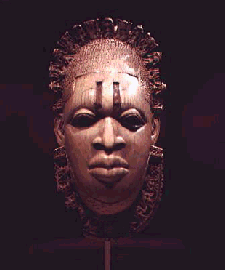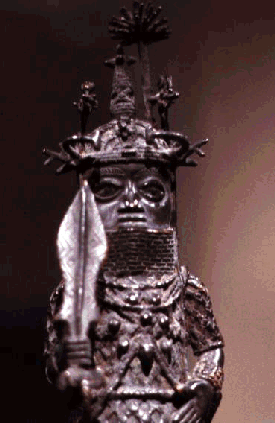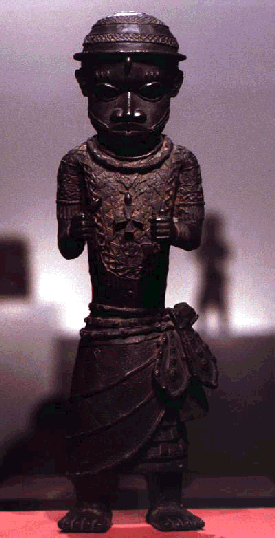
Article by Maunfu 9

One of the most impressive civilizations of the forest region of West Africa, the Kingdom of Benin was only one of a number of distinguished cultures produced by the Yoruba people of what is now Nigeria. Yoruba influence , in fact extends far beyond the borders of that country and far back in time as well.
One of the olders civilizations of the West African area is the Nok culture which was in existence as early as 500 B.C. This was an iron age culture of distinction which is thought to have been a predecessor of the Yoruba states of Ife ( around the eleventh century ) and Oyo which flourished as a thriving kingdom alongside Benin.
The Kingdom of Benin was established circa 1200 A.D. The use of written symbols was not widespread and was limited to secret societies of priests who used the form for sacred ritual. As such, much of Benin's history must be reconstructed through oral traditions and archaeological sources. The former of these attribute the creation of the Kingdom to Oranyan, a decendant of the ruling families of Ife. He was thus the first of the Oba - the kings of Benin. Oranyan established the initial state concurrent with the domination of the chiefs of the Ozama, then the dominant force in the region. It was not until the fifteenth century, when Benin suddenly subdued surrounding states and consolidated itself into a powerful Empire under the great monarch Ewuare. A period of expansion followed in which Ewuare extended the boundaries of his empire. Although he maintained absolute authority over lands within a forty mile radius of the city of Benin, frontier towns were allowed a degree of autonomy while thay paid tribute to the Kingdom
Like most visionary leaders, Ewuare established the state using clear ideas of nation-building. A council of advisors was established along with select guilds with specific duties and terms of service to the state. Over the next century, Benin would expand its suzereinity further afield as more neighbor states were brought under its dominion.

The written record providing descriptions of Benin exist mainly due to records kept by Dutch traders after the African contact with Europe. Like much other similar evidence, it makes clear that the initial contact and relationship between Europeans and Africans was not that of Master to slave but of equals. The record illustrates clearly how impressed the Dutch were with the city and people of Benin proper, a walled city with a deep moat encircling it.
Below is a report from a Dutch author believed to be Diereck Ruiters from Purchas His Pilgrims (1602):
The town seems to be very great, when you enter it. You go into a great broad street, not paved, which seems to be seven or eight times broader than than the Warmoes Street in Amsterdam; which goes right out and never crooked, and where I was lodged with Mattheus Cornelison it was at least a quarter of an hour going from the gate, and yet I could not see to the end of the street....
At the gate where I entered on horseback, I saw a very high Bulwarke, very thick of earth, with a very broad ditch, but it was dry, and full of high trees....The gate is a reasonably good gate, made of wood after their manner, which is to be shut, and there is always a watch held......
When you are in the great street aforementioned, you see many great streets on the sides thereof, which also go right forth, but you cannot see the end of them, by reason of their great length. A man might write more about the situation of this town, if he might see it as you may see the towns of Holland, which is not permitted there, by one that always goes with you - some men say that he goeth with you, because you should have no harm done to you, but yet you go no further than he will let you.
The houses [in Benin] stand in good order, one close and even with the other, as houses in Holland stand. Such houses as men of quality (who are gentlemen) or others dwell in, have two or three steps to go up; and in front there is as it were a gallery where a man may sit in the dry. This gallery is cleaned every morning by their slaves, and on it a mat is spread for men to sit down. Their rooms are four-square with a roof not closed in its middle so that rain wind and light come in. There they sit and take their; but they also have other places such as kitchens.....
The king's court is very great, having within it many four square yards surrounded by galleries, and where watch is always kept. I was so far within the court that I passed through four such yards, and wheresoever I looked, still I saw gate upon gate to go into other yards; and in this way, I went in as far as any Netherlander was: which was as far as the stable where his best horses are kept, always passing a great long way.
A hundred years later, Dutch merchant :William Bosman would comment on the manners and disposition of the citizens of the kingdom in A New and Accurate description of the Guinea Coast :
The inhabitants of Great Benin are generally good-natured and very civil, from whom it is easy to obtain whatever we desire by soft means. If we make them liberal presents, they will endeavor to recompense them doubly; and if we want anything and ask it of them, they seldom deny us, although they have occasion for it themselves.
But they are so far in the right, to expect that their courtesy should be repaid with civility, not with arrogance or rudeness; for to think of forcing anything from them, is to dispute with the moon.
They are very prompt in business, and will not suffer any of their ancient customs to be abolished; in which; if we comply with them, they are very easy to deal with, and will not be wanting in anything on their part requisite to a good agreement.
But worst of all is that they are very tedious in dealing. Many times they have a stock of elephant's teeth by them, which we are generally eight or ten days before we can agree with them for. But this is managed with so many ceremonious civilities that it is impossible to be angry at them.
John Barbot's contribution gives an idea of the nature of the state's political administration :
The King might be considered just and equitable, as desiring continually his officers to administer justice exactly, and to discharge their ideas conscientiously...He seldom passes one day, without holding a cabinet council with his chief ministers, for dispatching of the many affairs brought before him.......appeals from inferior courtrs of judicature in all parts of the kngdom, and audiences to strangers, or concerning the affairs of war and other emergencies......

Other Dutch visitors would report:
The King's palace is a collection of buildings which occupy as much space as the town of Haarlem [in Holland], and which is enclosed with walls. There are numerous apartments for the Prince's ministers and fine galleries, most of which are as big as those in the exchange at Amsterdam. They are supported by wooden pillars encased with copper, where their victories are depicted, and which are carefully kept very clean.
The town is composed of thirty main streets, very straight and 120 feet wide, apart from an infinity of small intersecting streets. The houses are close to one another, arranged in good order. These people are in no way inferior to the Dutch as regards cleanliness; they wash and scrub their houses so well that they are polished and shining like a looking glass.
Archaeology's most famous achievement in Benin is the unearthing of the now famous Benin Bronzes. Distinguished sculpture had however existed among the Yoruba for several centuries and there is a clear artistic lineage between the work of the Benin school of sculpture and those which preceded it particularly in Ife and Oyo as well as the Nok civilization. It is only recently that African historians have rescued these works ( intellectually speaking ) from the usual racism of caucasian specialists. At the discovery of these African masterpieces, Europe simply refused to believe that they were of indigenous origin and ascribed their creation to Greek and other Caucasian civilizers to the area despite the absence of any evidence whatsoever to support that claim. The sculpture of Ife and Benin were a match for anything produced by Europe. The process of their creation -known as the Lost Wax Method - is now a mystery to us, but the similarity of other architectural evidence which continues to come to the fore indicates that they were not a localised, fluke phenomenon, but an inherent product of the culture and history of the area. African art tends to be highly symbolic. The Yoruba masterpieces, however, are very naturalistic, particularly the Ife heads.The Benin heads, by contrast, retain an exaggeration of head sizes to approximately one quarter the size of the whole piece.
Yoruba culture, in fact, is highly developed in several fields. The Yoruba spiritual concept of Ifa is the progenitor of many religious forms of New World blacks including Santeria. In the face of the hegemony of the Catholic Church on these shores, Africans simply disguised their gods by renaming them using religious figures from church doctrine. The oral traditions of the Yoruba include an impressive 'literary' corpus which encompasses religion, philosophy and ethics. Its cosmogony is one of the most sophisticated and highly developed in existence. It is in this area, as well as in other traditions, including linguistics that the reputed origin of the Yoruba from ancient Egypt is best illustrated.
The late Cheikh Anta Diop states in African Origin of Civilization (p 184):
Egyptian Origin of the Yoruba:
In his volume, the Religion of the Yorubas ( Lagos: C.M.S. Bookshop, 1948 ) J. Olumide Lucas traces the Egyptian origin of this people as follows:
CONNECTION WITH ANCIENT EGYPT. While it is doubtful whather the view of an Asiatic origin is correct, there can be no doubt that the Yorubas were in Africa at a very early date. A chain of evidence leads to the conclusion that they must have settled for many years in that part of the continent known as Ancient Egypt. The facts leading to this conclusion may be grouped under the following heads:
A; Similarity or identity oof language;
B. Similarity or identity of religious beliefs;
C. Similarity or identity of religious ideas and practices;
D. Survival of customs and names of persons, places, objects etc.
(introduction, p18)
The author then cites many words common to Egyptian and Yoruba:
ran: name
Amon: concealed
miri: water
Ha: large house
Hor: to be high
Fahaka: silvery fish
naprit: grain ( or seed )
On the identity of religious beliefs, Lucas cites impressive facts:
Abundant proof of intimate connection between the ancient Egyptians and the Yoruba may be produced under this head. Most of the principal gods were well known, at one time, to the Yoruba. Among these gods are Osiris, Isis, Horus, Shu, Sut, Thoth, Khepera, Amon, Anu, Khonshu, Khnum, Khopri, Hathor, Sokaris, Ra, Seb, the four elemental deities, and others. Most of the gods survive in name or in attributes or in both (p. 21)
Ra survives among the Yoruba with his Egyptian name: Rara. Lucas cites the word I-Ra-Wo, which designates the star that accompanies the rising sun. This word starts with a vowel prefix, typical of Yoruba, an essentially phonetic language according to the author ( we would say: like all African languages ). Its other components are: Ra, the Egyptian word, and Wo: to rise. Lucas suggests that Rara, meaning; not at all, in Yoruba, indicates that they formerly swore by this god.
Similarly, the name of the lunar god Khonsu, is found among the Yoruba as Osu ( the moon ). Lucas reminds us that the occlusive kh does not exist in Yoruba, and that if a foreign word contains kh, it must follow this procedure: If kh is followed by another consonant, a vowel is added and forms a syllable according to the consonant-vowel rule in Yoruba. If kh is followed by a vowel in a word more than one syllable, it is simply dropped. This is the case with the word Osu.
Amon exists in Yoruba with the same meaning it has in ancient Egyptian: hidden. The god Amon is one of the first Deities known by the Yoruba and the words Mon and Mimon ( holy, sacred ) are probably derived from the name of that god, according to Lucas. Thoth would become To in Yoruba.
Next the author offers an interesting etymological analysis of the word 'Yoruba'. He points out that the West African term meaning "to exist" becomes ye by changing one vowel. When dopubled into yeye it means: 'she who makes me exist', whence yeye mi: my mother, she who gave me life. Incidentally, yaye means "mother" in Wolof, Sara, Baguirmian, etc. Yeye is often contracted into ye or iya; yemi: my creator, in Yoruba, is applied to the supreme deity.
Furthermore the Egyptian term Rpa is the name of the hereditary prince of the gods, by which Seb was known in ancient Egypt during the feudal period ( the author says ). Rpa probably evolved into ruba, in accordance with Yoruba linguistic rules; introduction of a vowel between two consonants and changing p to b. If we consider yo as merely a variant of ye, we get Ye + Rpe = Yoruba, which would probably mean "the living Rpa or the creator of Rpa"
Lucas presents an equally interesting analysis of the name applied to sheep by the Yoruba. He starts from the fact that the Greek word aiguptos is usually derived from the Egyptian hi-khu-ptah, which means the temple of the soul of Ptah. The walls of that temple were covered by pictures of sheep, along with other animals Consequently the name of the temple could be applied by the people to the animal depicted. In Yoruba, a-gu-to = sheep, and is to be compared with ai-gup-tos of the Greeks. This example would seem to indicate that the emigration of the Yoruba came later than the contact between Egypt and the Greeks....
...Lucas recalls that all the ontological notions of the ancient Egyptians, such as Ka, Akhu, Khu, Sahu, and Ba, are found in Yoruba. These words exist verbatim in Wolof and Peul, as will be seen below. The belief in the existence of a guardian spirit is but one aspect of Ka. Lucas expands for 414 pages, on the study of these beliefs and discusses in detail their identification with Egyptian beliefs. He concludes by noting the existence of Yoruba Hieroglyphics and cites several examples. The identity of the Egyptian and Yoruba pantheon alone would suffice to prove early contact.
Benin's influence was felt well into the slavery era when it underwent a marked decline.The rulers of the Kingdom were some of the staunchest resistors to the incursion of the slavery industry. Concerted efforts were made to ensure that citizens of the state would not be sold to bondage and significant predictable conflicts resulted with European powers such as the English in particular. As the West African coastal region became more and more negatively affected by the destructive results of the slave trade, Benin's great culture began to disintegrate. The social fabric itself was raptured and once powerful institutions eventually disintegrated, ushering in the era of colonization.